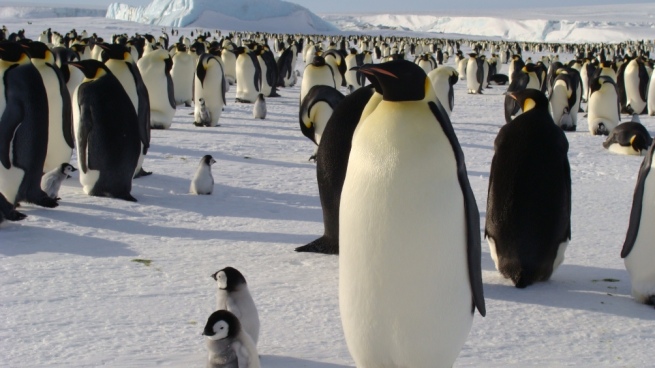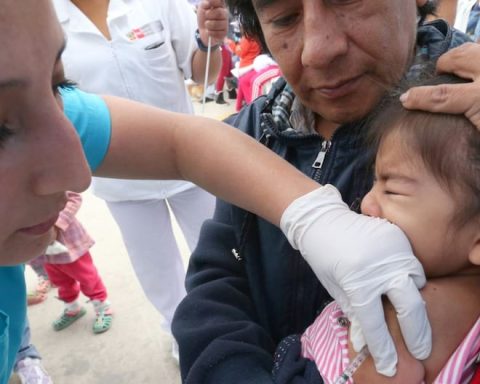The increase in temperatures caused by climate change melts the marine pack or frozen sea, a surface on which the emperor penguin develops the most important stages of its life cycle, which could lead to the virtual disappearance of this species, which is considered one of the the top predators of that continent.
Researchers from the Argentine Antarctic Institute (IAA) monitor penguin colonies in Antarctica every year. They do this by counting the number of adults that form the reproductive colonies.. This population parameter is important since it shows the size of the colonies and how it varies from year to year.
Researchers around the world warn that the loss of ice cover between the 60th and 70th parallels of south latitude could wipe out large numbers of the largest penguin colonies of all, the emperor, which plays a key role in the Antarctic balance as top predator.
Marcela Libertelli, a graduate in biological sciences and head of the IAA Top Predator Biology Department, stated in an interview with Télam that, “regarding the study of birds in AntarcticaIn addition to monitoring the emperor penguin, we also study the penguins of the Pygoscelis genus, which are the Adélie, the Chinstrap, and the Gentoo. They are smaller but more numerous, and also flying birds such as giant petrels, storm petrels or cormorants among others.”

“Our work is carried out in different Argentine Antarctic bases. We carry out surveys in the area of Base Carlini, Base Orcadas, Base Brown, Base Esperanza, Base Marambio and Base Primavera; furthermore, since 2014 we have been carrying out aerial surveys of a colony of emperor penguin over the Larsen C ice shelf with an Argentine Air Force Twin Otter plane,” he explained.
Libertelli said that “the top predators of Antarctica, both birds and mammals, give us a reference of the population stock of Antarctic marine living resources, as well as knowing their availability and the location of the stocks.”
And I add: “Having information on the main populations of prey such as krill and some species of fish is very important to know the status of the key populations that are part of the Antarctic food web.”
“This summer, as has been done for years, a new population census of all bird species will be carried out in the Orcadas base area, for the first time a survey of the cormorants that reproduce in the vicinity of the Brown Base will be carried out and in Carlini it is expected to advance with the studies that are carried out annually on giant petrels and storm petrels; studies on emperor penguin colonies are carried out between winter and spring south of the Marambio base, due to the fact that their reproductive cycle takes place between the months of April to December,” he stressed.
“The emperor penguin is the largest of the penguins, and unlike the rest it does not make a nest, but rather carries its egg between its legs all the time”Marcela Libertelli
The scientist stressed that “we have been researching these populations for years and we have seen that climate change affects bird populations, some of which are declining, as well as the impact produced by a growing tourist activity on the continent.”
“The emperor penguin is the largest of the penguins, and unlike the rest it does not make a nest, but rather carries its egg between its legs all the time and spends the most important stages of its life cycle on ice surfaces that are now losing due to climate change; if nothing changes, it is likely that in three or four decades most of the colonies of this species between the 60th and 70th parallels of south latitude will disappear,” he warned.
Libertelli assured that “the entire international Antarctic community is attentive to this situation and is considering declaring the emperor penguin a specially protected species, which would not solve the consequences of climate change but would at least prevent the tourist activities that today have the attraction of visiting those bird colonies can no longer get close to them.
“Another challenge faced by Antarctic predators is that of the fishing industry, there are countries like Norway, China, Russia or Japan that allow fishing in Antarctic waters at levels that affect the balance of ecosystems; within the scope of the Antarctic Treaty, seeks some consensus on the issue but it is complex because unanimity is needed to move forward,” he said.
Monitoring of Adélie, Chinstrap and Gentoo penguins is very important because they are very abundant populations that are considered key to studying the status of fish and krill populations.
The biologist added that “monitoring the Adélie, Chinstrap and Papua penguins is also very important because they are very abundant populations that are considered key to studying the status of fish and krill populations; for that it is necessary to go to their colonies to count nests, and during the season record how many nests have eggs, how many managed to hatch and how many survived.
“This is a job in which we also try to weigh some pigeons, take blood samples to better understand their physiology and see what pathogens or diseases they are exposed to, for this we take blood and feather samples, among others; and we have everything to do very delicately because if an adult gets scared and leaves the nest because of our presence, that chick can be devoured by a predator like the skua,” he said.
The researcher emphasized that “another very important line of research is that which deals with marine mammals, in the Carlini base area surveys are carried out on sea lions, sea elephants and some species of seal that may appear such as Weddell seals and crabeater seals, while the Orkney base monitors all the species of mammals that can be observed and that are great consumers of fish, krill, octopus and squid”.

“The melting of the Antarctic ice also affects marine mammals, the seals when they are going to give birth dig a hole in the ice for the pup, but if this ice is very thin they run the risk of the pup falling into the water and drowning “, he mentioned.
“In my case, I have participated in these surveys since 1996, and Argentina is one of the countries that works the most on monitoring these species and how climate change affects them, as well as other countries such as France, the United States, New Zealand, England, Australia and Spain among others”, Libertelli completed.

















